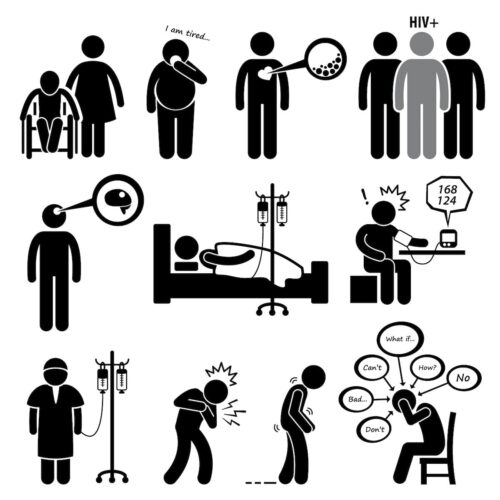So Why Is Physical Fitness Important? Being physically active and engaging in an exercise program is related to better health, increasing quality of life. Our ancestors were most of the time on the go, moving from place to place. We were created with the ability to be highly mobile. Being able to be physically active is not only a great asset, but a necessity to the human condition.
Exercise Benefits
Exercise can slow down aging and positively affect many systems:
- Metabolic rate, fat loss, muscle mass, and body composition
- Musculoskeletal strength and endurance
- Peristalsis, those muscular contractions needed for digestion, nutrient metabolism, and waste excretion
- VO2max (the maximum volume of oxygen used during exercise
- Muscle, joint, tendon, & bone health
- Capillary and heart conditioning
- Pulmonary function
- Sexual function
- Sleeping patterns
- Blood supply and oxygen consumption to cells, brain, and organs, allowing toxin removal, boosting energy, and helping balance pH levels
- Skin appearance
- Cognitive function
- Feelings of wellbeing, having a positive impact on your mood

How Much Physical Activity Do You Need?
Everyone knows that exercise is essential, but do you know how much exercise do you need to keep your body healthy? There are guidelines that have been established to help you keep your body healthy. This is what is recommended for adults and children:
- Adults should partake in aerobic activity of moderate intensity for at least 150 minutes a week — that’s 5 thirty-minute sessions of moderate cardio
- Or aerobic activity of vigorous-intensity for 75 minutes a week — that’s 3 twenty-five minute sessions of intense cardio
- Plus, 2 days of muscle-strengthening a week
- Children and adolescents should be physically engaged for at least 60 minutes a day, aerobically for at least 3 days a week, and engage in muscle-strengthening activities for 3 days.
What Happens When You are Inactive?
Now you know how much exercise you need, are you exercising enough? Unfortunately, most people are not. According to the Centers for Disease Control and Prevention (CDC), only 20% of adults meet the aerobic and muscle-strengthening guidelines. Only about 8% of adolescents (ages 12-19) and 42% of children (ages 6-12) get at least 60 minutes of physical activity per day. The lack of activity in the US is pervasive. A major problem with the modern US is that the majority of occupations involve sitting and more people than ever spend their time being physically inactive. Generally, people spend eight hours sitting down at their jobs, followed by more sitting in front of the TV, and then sleeping. Sitting for hours interferes with muscular and cellular systems involved in blood pressure, blood sugar, triglycerides, and cholesterol levels, raising them all, and increases toxic buildup.
Physical Effects Associated with Inactivity
One of the main problems associated with sedentarism is being overweight or obese. According to the Center for Disease Control and Prevention (CDC)’s 2020 report, 73% of adults (ages 20 and over) in the US are overweight with 42.4% of them being obese. What’s more alarming is that the prevalence of overweight states is also on the rise among children and adolescents: 17% are overweight, 18.5% are obese, with 6% of them being severely obese. Besides being overweight, lack of exercise causes numerous conditions. The CDC’ 2019 report stated that between 2015-2016 around 46% of the U.S. population used one or more prescription drugs; 18% of them were children under age 12, 27% adolescents, 47% adults aged 20–59, and 85% adults over age 60.
This is a list of the most frequent comorbidities associated with being sedentary and overweight:
- Chronic inflammation
- Coronary heart disease
- Stroke
- Cardiovascular disease
- High blood pressure
- Strokes
- High cholesterol
- Hypertension
- Type 2 diabetes
- Metabolic syndrome
- Pain
- Reflux disease and constipation
- Gallstones, gallbladder and kidney conditions
- Osteoarthritis
- Osteoporosis
- Carpal tunnel syndrome
- Asthma
- Sexual and fertility dysfunctions
- Urinary incontinence
- Pregnancy complications
- Sleeping disorders
- Nonalcoholic fatty liver disease (inflammation and excess fat in the liver not related to alcohol intake)
- Some types of cancer: esophageal, colorectal, pancreatic, breast, colon, endometrial,
- Higher death rates with those presenting cardiovascular disease

Psychological & Environmental Effects Associated with Being Sedentary & Overweight
Being sedentary and overweight not only affect your body, it can also affect a person’s mind, mood, and interactions:
- Depression
- Anxiety
- Low self-esteem and self-worth
- Eating disorders
- Body image disturbances
- Substance abuse
- Social isolation and stigma
- Impaired social functioning
- Lack of mindfulness
As you can see physical fitness has countless benefits. Exercise positively affects most systems in your body. It assists in keeping you sharp, looking young, and feeling happy. Inactivity, on the other hand, contributes to higher rates of disease. Being physically active is not optional, it’s not a luxury; it’s a necessity for our species.
Lift, Burn more Fat, Get Stronger, and Live Healthier!
To a Fitter Healthier You,
The Fitness Wellness Mentor



